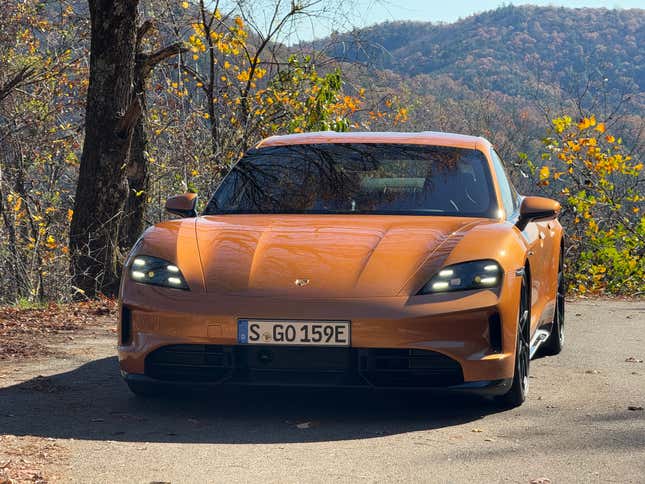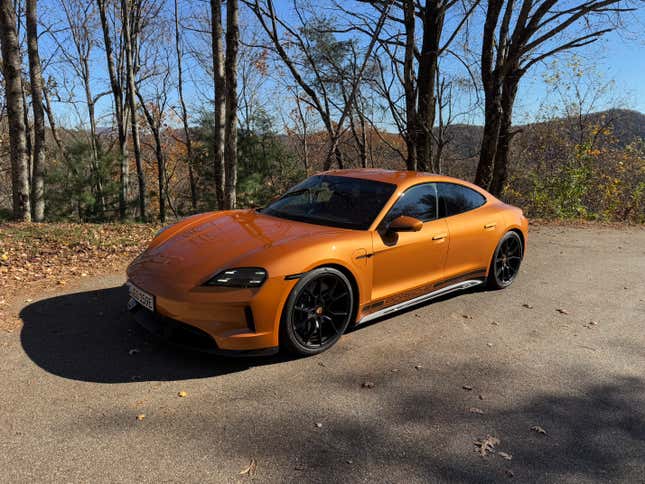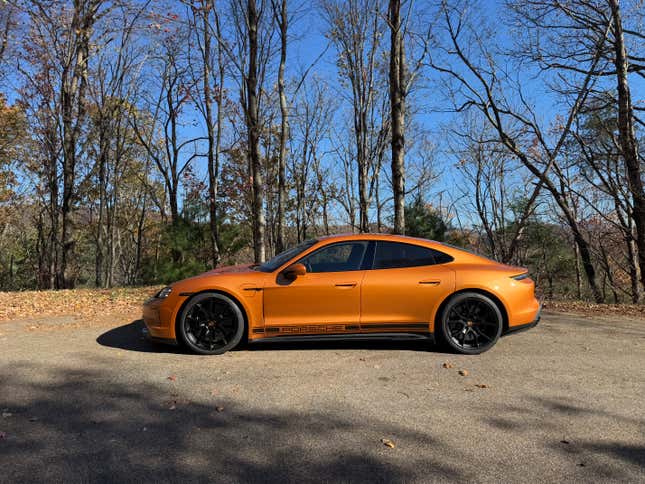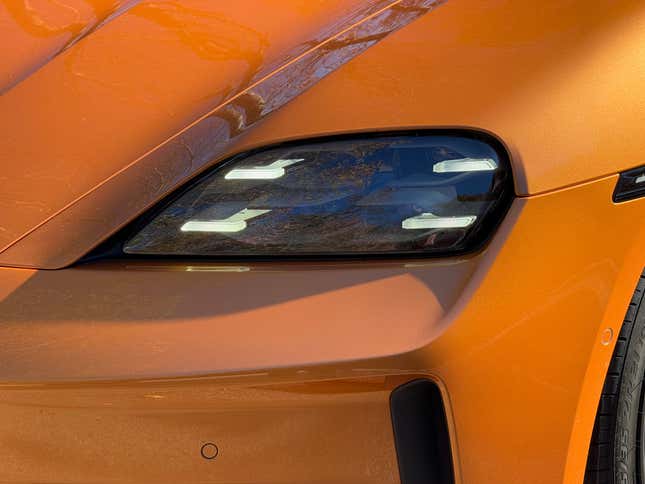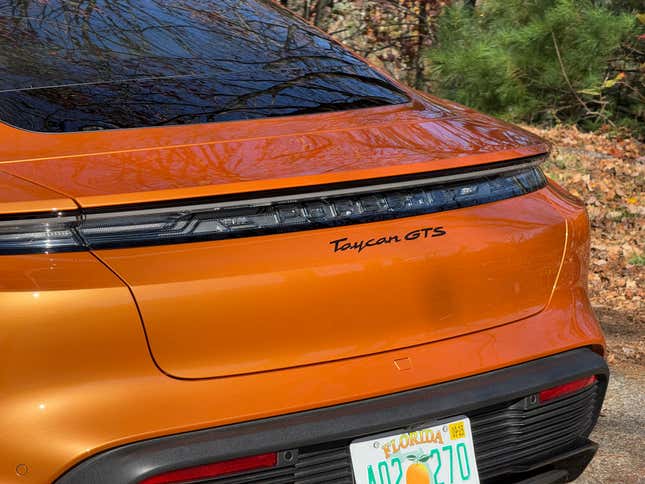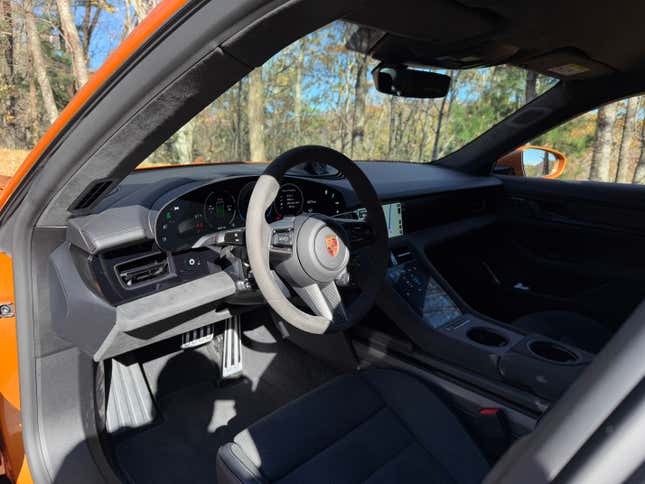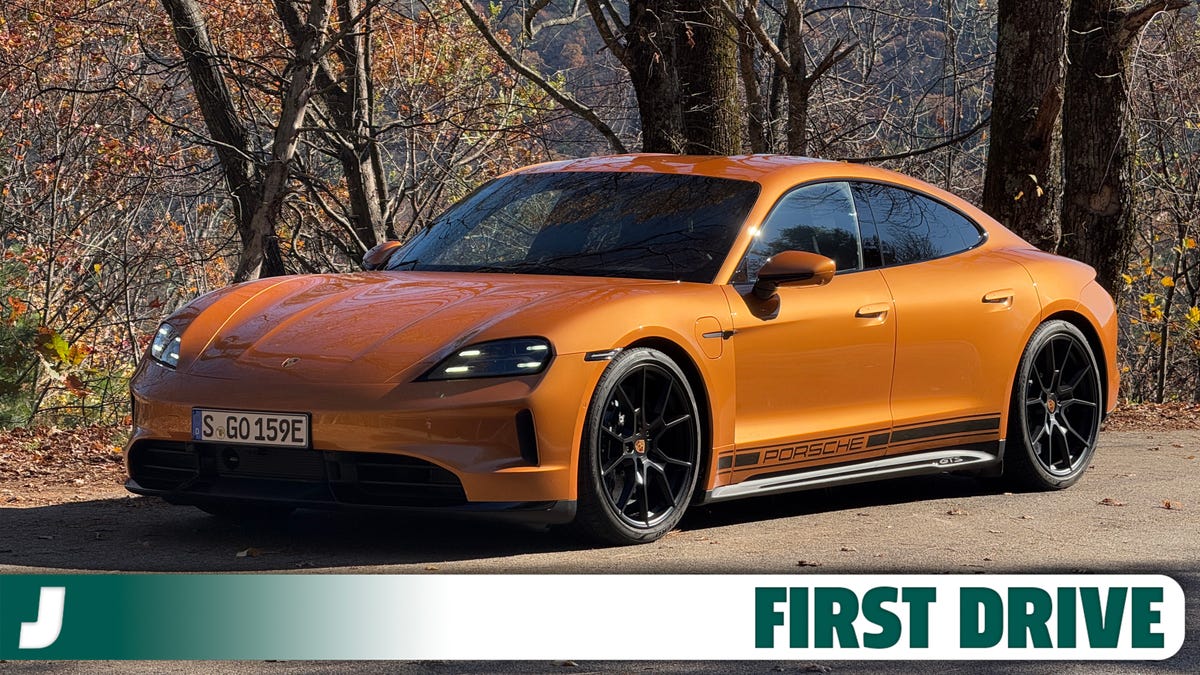Gold is so in right now. It’s become a popular new car color for the chic luxury set, and I’m not just saying that because I bought myself a stunning gold car earlier this year. In the fashion and architecture industries, gold is having a renewed moment. Hell, actual gold just hit an all-time high. I’m also thinking of gold because it’s awards season, my personal favorite season, and we’re coming off of a fantastic Olympics. If there were an automotive Olympics, or an automotive Oscar to give out, the 2025 Porsche Taycan GTS would take home the gold — and not just because of this one’s paint-to-sample Nordic Gold paint.
There are electric cars out there with more outrageous performance and speed, there are models that are sillier and more hoonable, there are certainly ones that are cheaper. But if what you’re looking for is the best overall performance EV, if you can only give out one award or something has to get gold, it’s the updated Taycan GTS. While none of the new stuff for the Taycan’s 2025 facelift is a total gamechanger (well, except one thing), it’s a comprehensive update that makes an amazing car even better.
Full disclosure: Porsche flew me to Atlanta, drove me out to northern Georgia and put me up in a nice hotel so I could drive the 2025 Taycan GTS and 2025 911 Carrera T. They even took us to a restaurant with German-style pretzels.
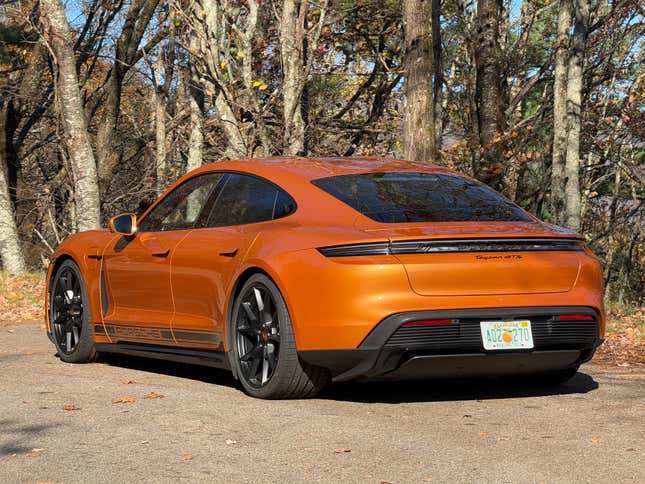
From the outside, you’d be forgiven for not thinking much has changed. The GTS shares its front end with other non-Turbo Taycans, and while I wasn’t a big fan of the redesigned bumper at first I think it’s growing on me, though that could just be because of this wonderful gold paint. You get more black and Anthracite Grey trim bits, the Sport Design splitter and different finishes for the wheels, but that’s about it. That Porsche side stripe is a $460 option; if that’s not cool enough, you can spend $1,210 on a Taycan decal set with a more dynamic design that adds a stripe across the hood and the roof as well.
For 2025 the Taycan GTS now makes 690 horsepower and 582 pound-feet when using launch control (or 596 hp and 534 lb-ft in normal driving), an increase of 100 hp over both last year’s GTS and what you get in the 2025 Taycan 4S. Every new Taycan has a more powerful rear-axle motor and larger battery packs, with the GTS only being offered with the bigger 105-kWh pack that’s optional on lowlier Taycans. Porsche says the GTS will now hit 60 mph in just 3.1 seconds, four tenths quicker than before, and go on to a quarter-mile run of 11.1 seconds, almost a full second quicker than before — and both of those figures feel conservative in the real world. The way the Taycan GTS accelerates is intense, not just when using launch control, and I love the kick you get when the two-speed transmission shifts. Despite the wild amount of power, crucially the GTS doesn’t feel too fast to actually use in the real world. You really don’t need the 871 horsepower of the Turbo, though that car’s 2.5-second 0-to-60 time definitely is entertaining.
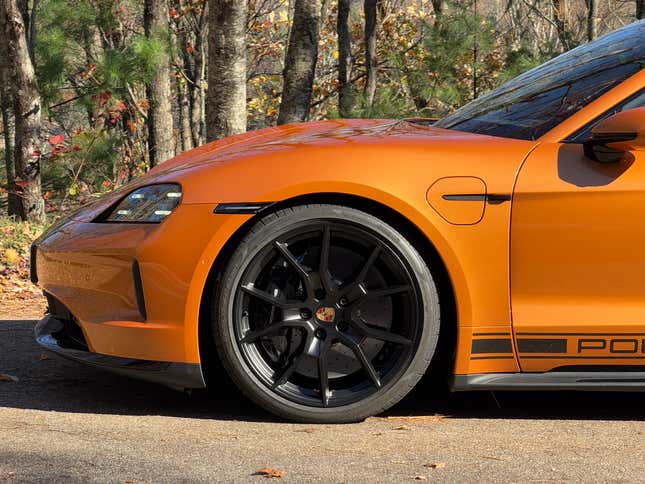
As part of the standard Sport Chrono package, a new push-to-pass button in the steering wheel’s drive mode dial unlocks 93 horsepower of extra juice for up to 10 seconds, and it raises the torque to the launch-control figure. It does make a noticeable difference if you need to pass a slow-moving vehicle or want to really blast out of a corner, plus the accompanying sounds and animated countdown timer in the gauge cluster are fun. If you spec the optional GT Sport steering wheel it comes with a pair of paddles, one of which activates the push-to-pass function and is definitely easier than reaching for the button.
Porsche still doesn’t do regenerative braking in the vein of other EVs, where you the car will begin to decelerate when you let off the accelerator, and I still think that’s a shame, but it’s not as disappointing when your brakes are as damn good as Porsche’s are. This particular Taycan GTS has the optional $9,070 carbon-ceramic brakes (add on an extra $910 for the black calipers) and they are some of the best on the market. There’s no fade, no squeaks, no aggressive tip-in, no jerky operation; just linear pedal feel and exceptionally strong braking power. The Taycan might not have the regen you’re used to, but it’s now able to recuperate up to 400 kW of energy under braking, and I can feel that recuperation working to help slow me down when I stomp on the left pedal.
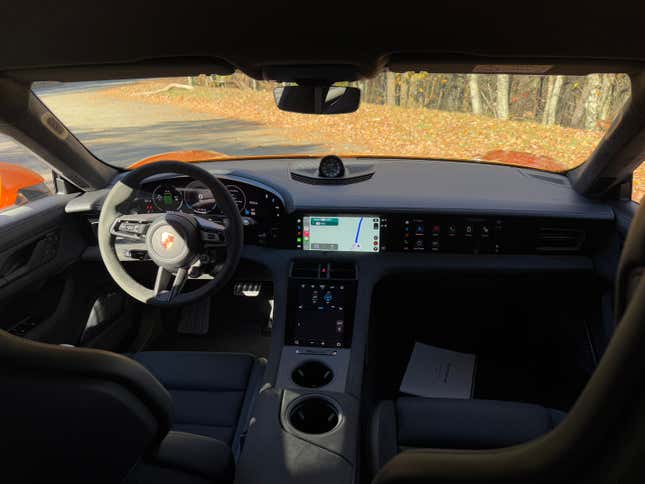
The Taycan GTS’ steering is simply excellent, with great feedback and a nice amount of heft while still feeling light and darty. It’s easy to make quick corrections, and the optional $1,340 rear-axle steering helps the Taycan feel smaller than it is. It steers just like any other Porsche sports car, and the tall fenders and low hood give you a similar view out to that of a 911, making the Taycan easy to place. Porsche Torque Vectoring Plus is included on every GTS, giving you an electronically controlled rear differential lock that can variably distribute torque between the rear wheels, further aiding in the car’s maneuverability and letting me get on the power earlier when cornering. The Pirelli P Zero summer tires on this GTS’ 21-inch wheels offer tons of grip, too.
As standard the Taycan GTS has Porsche’s Active Suspension Management, an adaptive air setup, but if you shell out $7,150 you can get the new Active Ride setup, which is genuinely magical and the gamechanger I mentioned before. Instead of using traditional anti-roll bars, the active dampers each have an electronically controlled hydraulic motor pump that can adjust compression, rebound and ride height in milliseconds. This gives the Taycan fantastic ride quality no matter the road conditions, and there’s essentially zero body roll. In the Normal drive mode you can have the Taycan lean into corners like a motorcycle, which is wonderful on highly banked mountain roads, and it can also keep the car totally flat under hard acceleration or braking — both are things you might not notice until it’s pointed out to you or until the systems are turned off and back on again, but once you experience them, you won’t want to go back. Those functions are unavailable in Sport and Sport Plus as Porsche wants the car to perform in a traditional manner, which I get, but it’s still a bit of a shame. Active Ride’s best party trick is its ability to instantly raise the ride height by over two inches when one of the doors is opened.

The one thing we don’t yet know about the 2025 Taycan GTS is its range, but it’s easy to make a guess. The Taycan 4S has an estimated range of 295 miles while the Turbo will do 292 miles, so the GTS should be rated at just under 300. With a 98-percent charge, this car showed a range of 274 miles, and at 74 percent after 58 miles of driving (some of that driving being very fast) it displayed a 173-mile range. Every 2025 Taycan is able to charge faster despite having larger batteries, thanks to a new heat pump and software tweaks, with Porsche saying it will take just 18 minutes to go from 10 to 80 percent when charging at the Taycan’s new peak of 320 kW, or a still-brisk 33 minutes at a 150-kW charger.
At $149,895 to start including $1,995 for destination, the Taycan GTS sits perfectly between the $120,495 Taycan 4S and the $175,595 Taycan Turbo. Option a 4S up to the GTS’ standard equipment level and the GTS looks even more like a bargain, especially once you factor in the extra power and GTS-specific chassis tweaks. Of course, it’s easy to send any Taycan’s pricetag into the stratosphere — this Nordic Gold one has an MSRP of $211,055, which is $100 more than a Taycan Turbo S’ starting price, and it doesn’t even have all the fanciest interior leather options or exterior carbon-fiber parts.
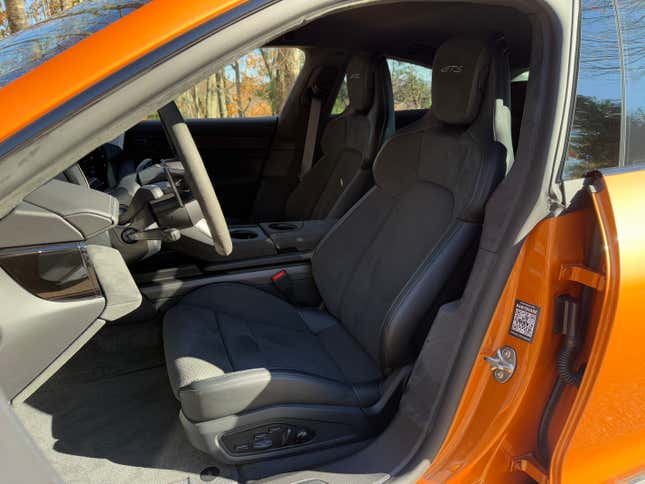
I could have gone with a Goldilocks metaphor for my intro, which does have “gold” in it, and I almost used the phrase “sweet spot” in the hed, in a knowing silly way, of course. I dare you to find a single review of any modern Porsche GTS model where the author doesn’t describe the car as “the sweet spot” of the lineup. Hell, even in Porsche’s pre-drive product briefing for the updated 2025 Taycan GTS, that phrase was used multiple times. It’s accurate, though. The GTS might not be the most powerful Taycan, or the most efficient Taycan, or the most affordable Taycan, but it‘s the most well-rounded, especially if you care about driving.
And if wagons are your thing, the Taycan GTS is even easier to decide on. While other Taycan trims are offered in Cross Turismo guise, which all have a slightly higher ride height and additional body cladding and fender flares, the GTS is the only Taycan available as a Sport Turismo wagon sans cladding. The GTS has had the highest take rate for the wagon out of the entire Taycan lineup, with 19 percent of pre-facelift GTS customers choosing the Sport Turismo. (The wagon made up 12 percent of the base trim sales, 7 percent of the 4S, 4 percent of the Turbo and 10 percent of Turbo S.) It only costs $1,900 extra to get the GTS Sport Turismo over the sedan. Do it.
